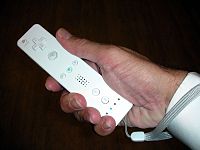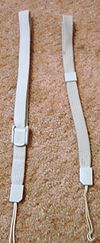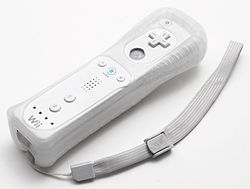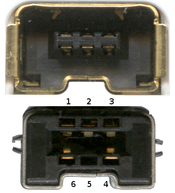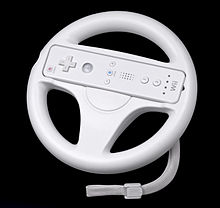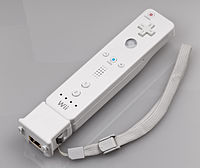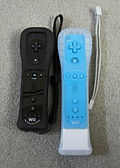- Wii Remote
-
Wii Remote 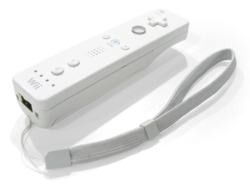
Wii Remote with original strapManufacturer Nintendo Generation Seventh generation era Retail availability November 19, 2006 Storage capacity 16 KiB EEPROM chip (16.3 kilobytes) Sound 1 speaker Input - Motion sensing (vertical axis, left-right horizontal axis, horizontal rotation)
- Infrared optical sensor
- 8 × Digital buttons
(A, B, -, +, Home, 1, 2, Power) - Digital D-pad
Connectivity Predecessor Nintendo GameCube controller Successor Wii Remote Plus, Wii U Controller The Wii Remote (Wiiリモコン Uī Rimokon), also known as the Wiimote, is the primary controller for Nintendo's Wii console. A main feature of the Wii Remote is its motion sensing capability, which allows the user to interact with and manipulate items on screen via gesture recognition and pointing through the use of accelerometer and optical sensor technology. Another feature is its expandability through the use of attachments. The attachment bundled with the Wii console is the Nunchuk, which complements the Wii Remote by providing functions similar to those in gamepad controllers. Some other attachments include the Wii Classic Controller, Wii Zapper, and the Wii Wheel, originally used for Mario Kart.
The controller was revealed at the Tokyo Game Show on September 14, 2005, with the name "Wii Remote" announced April 27, 2006. It has since received much attention due to its unique features and the contrast between it and typical gaming controllers. It has also gained significant attention from hackers using it to control non Wii-related devices through Wii homebrew.[1]
During Nintendo's presentation of Wii's successor console, the Wii U, it was announced that it will have support for the Wii Remote and its peripherals in games where use of its touchscreen-built-in primary controller is not imperative.
Contents
Development
Development of a motion enabled controller began in 2001, coinciding with development of the Wii console. In that year, Nintendo licensed a number of motion-sensing patents from Gyration Inc., a company that produces wireless motion-sensing computer mice.[2] Nintendo then commissioned Gyration Inc. to create a one-handed controller for it,[2] which eventually developed the "Gyropod", a more traditional gamepad which allowed its right half to break away for motion-control.[2] At this point, Gyration Inc. brought in a separate design firm Bridge Design to help pitch its concept to Nintendo.[3] Under requirement to "roughly preserve the existing Game Cube [sic] button layout", it experimented with different forms "through sketches, models and interviewing various hardcore gamers".[3] By "late 2004, early 2005", however, Nintendo had come up with the Wii Remote's less traditional "wand shape", and the design of the Nunchuk attachment.[4] Nintendo had also decided upon using a motion sensor, infrared pointer, and the layout of the buttons,[4] and by the end of 2005 the controller was ready for mass production.[4]
During development of the Wii Remote, video game designer Shigeru Miyamoto brought in mobile phones and controllers for automotive navigation systems for inspiration, eventually producing a prototype that resembled a cell phone.[4] Another design featured both an analog stick and a touchscreen, but Nintendo rejected the idea of a touchscreen on the controller, "since the portable console and living-room console would have been exactly the same".[4]
Sources also indicate that the Wii Remote was originally in development as a controller for the Nintendo GameCube, rather than the Wii. Video game developer Factor 5 stated that during development of launch title Star Wars Rogue Squadron II: Rogue Leader, it had an early prototype of a motion-sensing controller.[5] Video game journalist Matt Casamassina, from gaming website IGN, stated that he believed that Nintendo had planned to release the Wii Remote for the GameCube, noting that "Nintendo said that it hoped that GCN could enjoy a longer life cycle with the addition of top-secret peripherals that would forever enhance the gameplay experience."[6] He suggested that Nintendo may have wanted to release the Wii Remote with a new system, instead of onto the GameCube, as "[the] Revolution addresses one of the GameCube's biggest drawbacks, which is that it was/is perceived as a toy."[6]
Third-party use
Since the release of the Wii console, people have been exploring different new ways in which to use the Wii Remote. Many third-party applications are currently in development through Wii homebrew.[1] One popular Windows program called GlovePIE allows the Wii Remote to be used on a personal computer to emulate a keyboard, mouse or joystick. Connecting the Wii Remote to a personal computer is done via a Bluetooth connection. The Bluetooth program BlueSoleil has been proven to successfully connect a Wii Remote to a PC. Still another program (like GlovePIE) is needed to utilize the Wii Remote's protocol and to use the data it offers.
The Wii Remote Bluetooth protocol can be implemented on other devices including cell phones, which often have poor usability with games. Two students have demonstrated this concept by creating a driver software that has the capability to connect the Wii Remote to a Symbian OS smartphone. The idea behind this driver is that a mobile phone with a TV-out port can replace the game console.[7]
Johnny Lee's WiiMote Whiteboard software used for light pen-type computer input
Programmer Johnny Lee has posted video demos and sample code at his website related to the use of the Wii Remote for finger tracking, low-cost multipoint interactive whiteboards, and head tracking for desktop VR displays. This was the subject for his presentation at the prestigious TED conference, where he demonstrated several such applications. The WiimoteProject forum has become the discussion, support and sharing site for Lee's Wii Remote projects and other newer developments.
Studies have also been conducted to use the Wii Remote as a practice method to fine-tune surgeons' hand motions.[8] Utilizing DarwiinRemote, researchers at the University of Memphis have adapted the Wii Remote for data collection in cognitive psychology experiments.[9] Autodesk has released a plugin that allows the Wii Remote to control orientation of 3D models in Autodesk Design Review.[10]
Counterfeit units
As the Wii gained in popularity, reports surfaced of counterfeit Wii Remotes entering circulation. Although these devices may provide the same functionality as official Wii Remotes, the build quality is typically inferior and components such as the rumble pack and speaker are noticeably different. It is also unclear if current and future accessories will operate correctly with counterfeit units due to the differences in internal components.[11][12]
Design
The Wii Remote assumes a one-handed remote control-based design instead of the traditional gamepad controllers of previous gaming consoles. This was done to make motion sensitivity more intuitive, as a remote design is fitted perfectly for pointing, and in part to help the console appeal to a broader audience that includes non-gamers. The body of the Wii Remote measures 148 mm (5.83 in) long, 36.2 mm (1.43 in) wide, and 30.8 mm (1.21 in) thick. The Wii Remote model number is RVL-003, a reference to the project codename "Revolution". The controller communicates wirelessly with the console via short-range Bluetooth radio, with which it is possible to operate up to four controllers as far as 10 meters[13] (approx. 30 ft[14]) away from the console. However, to utilize pointer functionality, the Wii Remote must be used within five meters (approx. 16 ft) of the Sensor Bar.[15] The controller's symmetrical design allows it to be used in either hand. The Wii Remote can also be turned horizontally and used like a Famicom/NES controller, or in some cases (like Excite Truck, Sonic and the Secret Rings, Mario Kart Wii, and Sonic and Sega All-Stars Racing) a steering wheel. It is also possible to play a single-player game with a Wii Remote in each hand, as in the Shooting Range game contained in Wii Play.
At E3 2006, a few minor changes were made to the controller from the design presented at the Game Developer's Conference. The controller was made slightly longer, and a speaker was added to the face beneath the center row of buttons. The "B" button became more curved resembling a trigger. The "Start" and "Select" buttons were changed to plus "+" and minus "–", and the "b" and "a" buttons were changed to 1 and 2 to differentiate them from the "A" and "B" buttons. Also, the symbol on the "Home" button was changed from a blue dot to a shape resembling a home/house, the shape of the power button was made circular rather than rectangular, and the blue LEDs indicating player number are now labeled using small Braille-like raised dots instead of Arabic numerals, with "1" being "•", "2" being "••", "3" being "•••", and "4" being "••••". The Nintendo logo at the bottom of the controller face was replaced with the Wii logo. Also, the expansion port was redesigned, with expansion plugs featuring a smaller snap-on design.[16]
The blue LEDs also show how much battery power remains on the Wii Remote. By pressing any button, besides the power button while the controller is not being used to play games, a certain number of the four blue LEDs will light up, showing the battery life: four of the LEDs flash when it is at, or near, full power. Three lights flash when it is at 75%, two lights when at 50%, and one light flashes when there is 25% or less power remaining.
Similarities have been noted between the Wii Remote and an early Dreamcast controller prototype.[17]
In the Red Steel trailer shown at E3 2006, the Wii Remote featured a smaller circular shaped image sensor, as opposed to the larger opaque IR filters shown on other versions.[18] In the initial teaser video that revealed the controller at Tokyo Game Show 2005, the 1 and 2 buttons were labeled X and Y, respectively.[19]
Colors
At the E3 2006 trade show, Nintendo displayed white, black, and blue controllers;[citation needed] press images released for the event featured white, red, silver, lime green, and black versions.[20] The Wii console and controllers launched in only white versions, with Shigeru Miyamoto commenting that new hues will be provided after the relief of supply limitations.[21]
On June 4, 2009, Nintendo revealed that it would release black versions of the Wii, Wii Remote, Nunchuk, and Classic Controller PRO in Japan on August 1, 2009. Each black Wii Remote includes a matching solid-black Wii Remote Jacket.[22][23] In addition, Club Nintendo in Japan held a contest between June 25, 2009 and August 31, 2009 wherein members who purchased and registered a copy of Wii Sports Resort would be entered into a drawing to win one of 5000 blue controller sets. Each set included a Wii Remote, Wii MotionPlus, and Nunchuk, all in a sky blue color referred to as Mizuiro distinct from other blue Wii Remotes.[24][25]
For North America, Nintendo announced on September 1, 2009 that black versions of the Wii Remote, Wii MotionPlus, and Nunchuk will be released during the holiday season.[26] On November 16, 2009, the black Wii Remote and Wii MotionPlus was released as a bundle, and the black Nunchuk was released as a standalone purchase.[27]
Blue and pink Wii Remotes were released in Japan on December 3, 2009.[28] In North America, the blue and pink Wii Remotes were released February 14, 2010 in a bundle with a standard white Wii MotionPlus.[29]
In Australia, the black, blue and pink versions of the Wii Remotes were released on February 25, 2010. In addition, the black Nunchuk and black Wii MotionPlus were also released on that day as well.[30]
On September 29, 2010, Nintendo announced the Wii Remote Plus which was a standard-size Wii Remote with a built in WiiMotionPlus which would be available in white, black, blue, and pink. [31] It was released in Australia on October 28, 2010, in Europe on November 5, 2010, in North America on November 7, 2010, and in Japan on November 11, 2010. From that point it was available with the games FlingSmash and Wii Play: Motion as well as selling as a standalone and with every new Wii console.
Nintendo released a limited edition red Wii for the 25th anniversary of Super Mario Bros on November 17, 2010 in Japan,[32] October 29, 2010 in Europe,[33] and November 7, 2010 in North America.[34] The bundle includes a Red Wii Remote Plus and Nunchuk.
At E3 2011, Nintendo announced that a gold Wii Remote Plus styled with a Triforce logo would release alongside The Legend of Zelda: Skyward Sword and would be available as a bundle with the game for a limited time.[35]
Strap
The Wii Remote comes with a wrist strap attached to the bottom to ensure the safety of the device. Most Wii games displays a caution screen upon loading to warn the player to use the strap in order to avoid the remote slipping from the grip during erratic movements.
Video game web site IGN reported that the strap tends to break under heavy use,[36] which would potentially send the Wii Remote flying in various directions. WarioWare: Smooth Moves also sometimes requires the Wii Remote to be dropped, which would cause problems in the event of a strap failure. In response, Nintendo has posted guidelines on proper use of the strap and the Wii Remote.[37] On December 8, 2006, units with thicker straps began to appear in some areas of the world.[38] On December 15, 2006, Nintendo denied reports of a Wii wrist strap recall. While Nintendo refuted claims that three million straps had been recalled, it provided replacement wrist straps free of charge for users who have broken theirs.[39] However, the U.S. Consumer Product Safety Commission has become involved in the "replacement program".[40] The old 0.6 mm (0.024 in) diameter strap is replaced by a larger, 1.0 mm (0.039 in) diameter version. Nintendo's online "Wrist Strap Replacement Request Form" allows owners to receive up to four free straps when a Wii serial number and shipping details are provided.
On August 3, 2007, a new wrist strap was discovered to be in circulation. The strap featured a lock clip instead of a slide to ensure that the clip would not slide away from a player's wrist during frequent play.[41] The lock clip wrist strap is featured in the newest wrist strap reminder screens.
Jacket
Nintendo announced a free accessory for the Wii Remote,[42] the Wii Remote Jacket, on October 1, 2007. The removable silicone sleeve wraps around the Wii Remote to provide users a better grip and cushioning. The cushioning intends to keep the Wii Remote protected in case it is accidentally dropped or thrown. Nintendo started shipping consoles, separately-packaged controllers, and the controller included in the game Wii Play with the jacket on October 15, 2007. As with the wrist strap replacements, Nintendo has put up a Wii Remote Jacket request form on its Australian[dead link], British, Danish[dead link], Dutch[dead link], Spanish[dead link], Italian, North American and South African websites allowing current Wii owners to request up to four of the jackets free of charge, including shipping charges.
Home Menu
Accessed with the Wii Remote's home button, the Home Menu displays information about the controller(s) currently being used, and allows the user to configure certain options. At the bottom of the menu screen, the battery life of all connected controllers is displayed. Below that is a bar labeled Wii Remote Settings. Selecting it brings users to an options screen where they can control the audio output volume, rumble settings, and reconnect the controllers, for example to connect Wii Remotes through one-time synchronization. Depending on when the Home Menu is accessed, there will be a different amount of buttons displayed.
Wii Menu: No matter when the menu is accessed, the Wii Menu button will always be present. Selecting this will bring back the Wii Menu, where users can choose another channel. When playing certain Virtual Console titles, this will also create a suspend point.
Reset: In applications, the Reset button is available. This performs a soft reset of that particular application, for example returning a game to its title screen or returning to the loading screen of a Wii Menu channel, what would happen if the player were to press the console's physical reset button.
Operations Guide: On Wii Menu channels, including the News Channel, Forecast Channel, Internet Channel, Everybody Votes Channel and Virtual Console titles, the Operations Guide button will appear on the Home Menu. The guide accessed acts as an instruction manual for the currently played game.
The Home Menu can be compared to the Xbox 360's in-game menu (accessible by the "Xbox" button), or the PlayStation 3's XMB. It may be accessed under most circumstances during Wii operation, which pauses the on-screen action. Otherwise a Home symbol with a strikethrough appears onscreen. It is also inaccessible during Nintendo GameCube play.
Functionality
Sensing
The Wii Remote has the ability to sense acceleration along three axes through the use of an ADXL330 accelerometer.[15][43] The Wii Remote also features a PixArt optical sensor, allowing it to determine where the Wii Remote is pointing.[44]
Unlike a light gun that senses light from a television screen, the Wii Remote senses light from the console's Sensor Bar (model number RVL-014), which allows consistent usage regardless of a television's type or size. The Sensor Bar is about 20 cm (8 in) long and features ten infrared LEDs, five at each end of the bar[45] The LEDs furthest from the center are pointed slightly outwards, the LEDs closest to the center are pointed slightly inwards, while the rest are pointed straight forward. The Sensor Bar's cable is 353 cm (11 ft 7 in) in length. The bar may be placed above or below the television, and should be centered. If placed above, the sensor should be in line with the front of the television, and if placed below, should be in line with the front of the surface the television is placed on. It is not necessary to point directly at the Sensor Bar, but pointing significantly away from the bar will disrupt position-sensing ability due to the limited viewing angle of the Wii Remote.
Use of the Sensor Bar allows the Wii Remote to be used as an accurate pointing device up to 5 meters (approx. 16 ft) away from the bar.[14] The Wii Remote's image sensor[44] is used to locate the Sensor Bar's points of light in the Wii Remote's field of view. The light emitted from each end of the Sensor Bar is focused onto the image sensor which sees the light as two bright dots separated by a distance "mi" on the image sensor. The second distance "m" between the two clusters of light emitters in the Sensor Bar is a fixed distance. From these two distances m and mi, the Wii CPU calculates the distance between the Wii Remote and the Sensor Bar using triangulation.[46] In addition, rotation of the Wii Remote with respect to the ground can also be calculated from the relative angle of the two dots of light on the image sensor.[47] Games can be programmed to sense whether the image sensor is covered, which is demonstrated in a Microgame of Smooth Moves, where if the player does not uncover the sensor, the champagne bottle that the remote represents will not open.
The Sensor Bar is required when the Wii Remote is controlling up-down, left-right motion of a cursor or reticle on the TV screen to point to menu options or objects such as enemies in first-person shooters. Because the Sensor Bar also allows the Wii Remote to calculate the distance between the Wii Remote and the Sensor Bar,[48] the Wii Remote can also control slow forward-backward motion of an object in a 3-dimensional game.[49] Rapid forward-backward motion, such as punching in a boxing game, is controlled by the acceleration sensors. Using these acceleration sensors (acting as tilt sensors), the Wii Remote can also control rotation of a cursor or other objects.[50]
The use of an infrared sensor to detect position can cause some detection problems when other infrared sources are around, such as incandescent light bulbs or candles. This can be easily alleviated by using fluorescent lights around the Wii, which emit little to no infrared light.[51] Innovative users have used other sources of IR light as Sensor Bar substitutes such as a pair of flashlights and a pair of candles.[52] Such substitutes for the Sensor Bar illustrate the fact that a pair of non-moving lights provide continuous calibration of the direction that the Wii Remote is pointing and its physical location relative to the light sources. There is no way to calibrate the position of the cursor relative to where the user is pointing the controller without the two stable reference sources of light provided by the Sensor Bar or substitutes. Third-party wireless sensor bars have also been released.
The position and motion tracking of the Wii Remote allows the player to mimic actual game actions, such as swinging a sword or aiming a gun, instead of simply pressing buttons. An early marketing video showed actors miming actions such as fishing, cooking, drumming, conducting a musical ensemble, shooting a gun, sword fighting, and performing dental surgery.[53]
The LEDs can be seen through some cameras and other devices with a wider visible spectrum than the human eye, such as most digital cameras and camera phones.
The Wii Remote also has twelve buttons. It has a power button to toggle the Wii on and off, a d-pad which is interpreted as four separate buttons, and buttons labeled "A", "B", "1", "2", "home", "-", and "+".
Controller feedback
The Wii Remote provides basic audio and rumble functionality. At the 2006 E3 press conference, it was revealed that the Wii Remote has its own independent speaker on the face of the unit. This was demonstrated by a developer as he strung and shot a bow in The Legend of Zelda: Twilight Princess. The sound from both the Wii Remote and television was altered as the bow shot to give the impression of the arrow traveling away from the player. Another example of its use is in Red Steel's Killer match, where the players will receive their objective through the Wii Remote's speaker or No More Heroes' feature allowing players to listen to phonecalls through the Wii Remote, which was also used in Silent Hill: Shattered Memories[54] and GoldenEye 007. The volume can be changed or muted with the "Home" button and selecting the corresponding controller icon at the bottom of the screen.[55] The rumble feature can also be switched on or off using the Home Menu.[55]
Memory
The Wii Remote contains a 16 KiB EEPROM chip from which a section of 6 kilobytes can be freely read and written by the host.[51][56] Part of this memory is available to store up to ten Mii avatars, which can be transported to use with another Wii console. At least 4,000 bytes are available and unused before the Mii data. Pokémon Battle Revolution and Super Swing Golf also use this memory. This function is also used in Super Smash Bros. Brawl, allowing the user to save controller configuration data to the Wii Remote. Monster Hunter Tri also uses this function by allowing players to save their profiles to the Wii Remote.[57]
Power source
The Wii Remote uses two AA batteries as a power source, which can power a Wii Remote for 60 hours using only the accelerometer functionality and 25 hours using both accelerometer and pointer functionality.[51] An official direct recharging option for the Wii Remote does not exist, but various third-party manufacturers market charging solutions for the controller (see Wii Remote Chargers). According to an interview with Nintendo industrial designer Lance Barr, limitations of the Wii Remote's expansion port make it unlikely that it will be used for internal battery charging.[58] Although Nintendo discourages other rechargeable battery types such as lithium ion (Li-ion) and nickel-cadmium (NiCd), the company's support website indicates that nickel-metal hydride (NiMH) rechargeable batteries may be used.[59] A 3300 µF capacitor provides a temporary source of power during quick movements of the Wii Remote when connection to the batteries may be temporarily interrupted.[56]
Expansions and accessories
The Wii Remote also features an expansion port at the bottom which allows various functional attachments to be added. The connector, and any accessories that attach to it, use a 400 kHz I²C protocol. This expandability is similar to that available with the port on the Nintendo 64 controller.
Nunchuk
Nunchuk 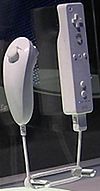
A Nunchuk (left) plugged into a pre-release Wii Remote, as shown at E3 2006Manufacturer Nintendo Generation Seventh generation era Retail availability November 19, 2006 Input - 1 × Control Stick
- 2 × Digital buttons
(C, Z) - Motion sensing (vertical axis, left-right horizontal axis, horizontal rotation)
The Nunchuk (model number RVL-004) is the first attachment Nintendo revealed for the Wii Remote at the 2005 Tokyo Game Show. It connects to the Wii Remote via a cord that is about 3.5 to 4 feet (1 ~ 1.2 m) long. Its appearance when attached resembles the nunchaku, hence the name. It features an analog stick similar to the one found on the GameCube controller and two trigger buttons (a last-minute modification changed the two triggers to one trigger and a "C" button, as described below). It works in tandem with the main controller in many games. Like the Wii Remote, the Nunchuk also provides a three-axis accelerometer for motion-sensing and tilting, but without a speaker, a rumble function, or a pointer function.[60][61] The Nunchuk's accelerometer is an STMicroelectronics LIS3L02AL.[62]
One Nunchuk comes bundled with the Wii console. Additional Wii Remote units are sold separately without the Nunchuk.[63][64] The two shoulder buttons, formerly named Z1 and Z2 respectively, had been reshaped and renamed since the Game Developers Conference. The circular top shoulder button, now called C, is much smaller than the lower rectangular shoulder button, now called Z.[65]
The body of the Nunchuk measures 113 mm (4.45 in) long, 38 mm (1.5 in) wide, and 37 mm (1.48 in) thick.[15] The connection port was also larger.[66]
The Nunchuk can be connected to any microcontroller capable of I²C (e.g. Arduino's Atmel AVR), where the accelerometer, joystick and buttons data may be accessed. Todbot has created the Wiichuck, an adapter to facilitate connecting the Nunchuk to an Arduino board.[67]
In 2008, wireless Nunchuks became available from one or more third party providers, eliminating the cord that links the Wii Remote with the Nunchuk.[68]
Classic Controller
Main article: Classic ControllerThere are two versions of the Classic Controller, the original Classic Controller and the Classic Controller Pro.
Classic Controller
At the 2006 Electronic Entertainment Expo, Nintendo introduced the Classic Controller, which plugs into the Wii Remote via a cord in a similar fashion to the Nunchuk.[15] Unlike most accessories, the Classic Controller largely usurps the Remote's functionality, with the Remote's buttons duplicated on the Controller. The Remote is used primarily as a wireless transmitter for the Controller and where applicable retains its pointing-device functionality.
The Classic Controller is reminiscent of the controller for the Super Nintendo Entertainment System, being the same size and having the A, B, X, Y, L and R buttons and directional pad in the same location. It also contains two analog sticks and two extra shoulder buttons used to replicate additional components found on the Nintendo GameCube controller. The controller is primarily used for Virtual Console titles, with several titles requiring either the Classic or GameCube controller to play, being optimized for the Classic Controller. Several retail Wii titles are also compatible with the controller to allow for a more traditional control scheme.
Classic Controller Pro
A revamp of the original Classic Controller named the "Classic Controller Pro" was later released, with its shape, shoulder buttons and controller grips more similar to other major seventh generation console controllers. The Classic Controller Pro is available as a standalone accessory, and at the time of its release was also available in a bundle with Monster Hunter Tri. A gold version of the Classic Controller Pro is also available with GoldenEye 007 Classic Edition, and a red version is slated to be available along with Xenoblade Chronicles.
Wii Zapper
Main article: Wii ZapperThe Wii Zapper is a gun shell accessory for the Wii Remote. As shown in the image, the shell receives both the Wii Remote and Nunchuk, and contains a trigger that actuates the Wii Remote's B button; all other buttons are still accessible while the remote and Nunchuk are in the shell. The name is a reference to the NES Zapper light gun for the Nintendo Entertainment System. According to an interview with Shigeru Miyamoto, the idea of a Zapper-type expansion formed when the Wii Remote was first created. He expressed that "What we found is that the reason we wanted to have a Zapper is when you hold a Wii Remote, it can be difficult for some people to keep a steady hand. And holding your arm out like that can get your arm somewhat tired."[69] The Zapper is useful for most games primarily involving gun-style weapons, such as light gun shooters, first-person shooters, and third person shooters.
Wii Wheel
A Wii Wheel accessory comes packaged with Mario Kart Wii and later Sonic and SEGA All-Stars Racing. A button which triggers the Wii Remote's "B" button protrudes from the back of the Wii Wheel; however, the wheel itself adds no functionality beyond ergonomics. The wheel has a large, encircled Wii logo at the back's middle, although this has no function.[70] The Wii Wheel has a hole on the right side in the back to allow use of the wrist strap while the Wii Remote is attached to the accessory, and to make removing the remote from the wheel easier. The user is also able to use the pointing function of the Wii Remote while it is in the peripheral through a hole on the left. The Wii Wheel can be used for games that share a sideways steering control configuration. The Wii Wheel competes with Microsoft's Xbox 360 Wireless Racing Wheel and Logitech's Driving Force GT as part of the seventh generation of racing wheels.
A special gold version of the Wii Wheel was given as a Platinum Status Gift to Japanese Club Nintendo Members, and was also available to European Club Nintendo Members for 4000 stars.
One Wii Wheel is packaged with Mario Kart Wii, but more can be bought separately.[71] Excitebots: Trick Racing is also optionally packaged with a Wii Wheel, and F1 2009 comes with a modified version of the Wii wheel, shaped like the wheel used in Formula One cars.
Wii MotionPlus
Main article: Wii MotionPlusThe Wii MotionPlus is an expansion device that allows the Wii Remote to more accurately capture complex motion. Incorporated with a custom version of the Wii Remote Jacket,[72][73] the Wii MotionPlus affixes directly to the Wii Remote expansion port, extending the length of the controller body by approximately 1½ inches (4 cm).[74] The Wii MotionPlus uses a Tuning fork gyroscope,[75] which supplements the accelerometer and Sensor Bar capabilities of the Wii Remote, enabling controller motions to be rendered identically on the screen in real time, according to Nintendo.[76] It is sold individually, as well as released in bundles with some MotionPlus compatible games such as Nintendo's Wii Sports Resort and "Red Steel 2" from Ubisoft.[72][73] Black Wii Remotes bundled with the MotionPlus add-on were released in Europe in November 2009.
Wii Remote Plus
Main article: Wii Remote PlusIn November 2010 Nintendo released the Wii Remote Plus, a regular-sized Wii Remote that has the functionality of the MotionPlus accessory.
Wii Vitality Sensor
The Wii Vitality Sensor is a fingertip pulse oximeter sensor that connects through the Wii Remote. According to Nintendo, the device "will initially sense the user's pulse and a number of other signals being transmitted by their bodies, and will then provide information to the users about the body’s inner world." The Wii Vitality Sensor was announced by President and CEO Satoru Iwata at Nintendo's E3 2009 media briefing on June 2. No specific applications were revealed for the device, but when presenting the device Iwata suggested that video games may soon be used for relaxation.[77][78] According to Nintendo of America president Reggie Fils-Aime, more details concerning the Wii Vitality Sensor were to be showcased during E3 2010, although no mention of the device occurred.[79] Reggie told GameTrailers, "(E3) was not the kind of environment for a game based on relaxation", mentioning they are saving news on the device for another time and place.[80] At E3 2010, Ubisoft introduced their own pulse oximeter sensor, "Innergy".[81] However, at E3 2011, Nintendo announced more about the Wii Vitality Sensor. Shigeru Miyamoto said that the Wii Vitality Sensor has a difficult time performing consistently across a variety of situations but still may be released.[82]
Third-party accessories
Main article: Third-party accessories for the Wii RemoteSince the release of the Wii console, many aesthetic, ergonomic, and functional accessories have been developed for the Wii Remote by third parties.[83]
Reception
Overall reception to the Wii Remote has changed over time. The control styles provided by the controller were met with praise at its first public exhibition at E3.[84] Since then, comments have been noted by the press on its functionality. Matt Wales of IGN UK highlighted the aiming and precision of Red Steel and stated "Taking down swathes of enemies with nothing more than a twitch of the wrist proves immensely satisfying and, more importantly, incredibly involving."[85] Nintendo Power listed the Wii Remote as an innovative controller, citing it as innovative for several firsts, including the first use of motion control, the first built-in speaker, and the first Infrared Pointer.[86] This is incorrect, however; the first video game controller to make use of motion sensitivity was Le Stick for the Atari 2600 and Commodore 64, manufactured by Datasoft Inc, and released in 1981.[87]
Other publications have noted specific complaints regarding control. GameSpot expressed that some motions in Cooking Mama: Cook Off failed to transmit or meet expectation during gameplay.[88] Similar observations were made on other titles made available during the Wii launch period. ComputerAndVideoGames.com reported that "Most prominent is the first batch of games, many of which do a better job at exposing the obstacles of full motion control, rather than the benefits... Need For Speed...is near unplayable, Far Cry got it all wrong, and the motion control in Marvel: Ultimate Alliance just feels tacked on."[89]
The overall situation was described by Joystiq thus: "Over the months since launch, the unpredictable Wii Remote has led to a maddening dichotomy. Some games are too easy, while others are too hard -- for all the wrong reasons...Gamers who crave a deeper challenge have to settle for battling incomprehensible controls."[90] Critics felt that fault was largely attributed to the developers' lack of experience with the Wii Remote. Jeremy Parish of the magazine Electronic Gaming Monthly compared the initial phase of control implementation to that of the Nintendo DS.[91] Matt Casamassina of IGN also presumed that the first generation of Wii games were of an experimental stage and that potential for refinement had yet to be exploited.[92]
Later-released titles have seen mixed reactions in terms of control. Of Tiger Woods PGA Tour 07 from Electronic Arts, Matthew Kato of Game Informer stated that the controller "has a hard time detecting your backswing. Thus, it’s harder to control. There were even times the game putted for me by accident."[93] A GamePro review for Medal of Honor: Vanguard offers that the title "is an encouraging sign that developers are finally starting to work out the kinks and quirks of the Wii Remote."[94]
First- and second-party titles have produced more favorable utilization of the Wii Remote's unique capabilities. Metroid Prime 3: Corruption ,in particular, was nearly universally praised for its unique control scheme, which is seen as being unrivaled by any other console game.[95] Corruption utilizes the Nunchuk for strafing and the infrared pointing capability of the Wii Remote for turning and special "gestures", which are used to select visors. Other Nintendo titles take a more minimalist approach, using mostly the pointer and buttons only, as with Big Brain Academy: Wii Degree, or use the controller in a sideways configuration to resemble an Nintendo Entertainment System controller while de-emphasizing more advanced capabilities, as seen in Super Paper Mario.[96]
The Wii Remote and Nunchuk combined to sell over 8.5 million units in the United States, and took the top two spots in video game accessories sales in 2006.[97] In the U.S., the Nunchuk was the best-selling video game hardware for January 2008, with 375,000 units sold, in a month where the Wii was the best-selling console with 274,000 units sold.[98][99]
See also
- List of Wii games
- Wii Balance Board
- Wii Speak
- PlayStation Move
- Kinect
References
- ^ a b Jamin Brophy-Warren, Magic Wand: How Hackers Make Use Of Their Wii-motes, Wall Street Journal, April 28, 2007
- ^ a b c Rothman, Wilson (2007-08-29). "Unearthed: Nintendo's Pre-Wiimote Prototype". Gizmodo. http://gizmodo.com/gadgets/exclusive/unearthed-nintendo-2001-prototype-motion+sensing-one+handed-controller-by-gyration-294642.php. Retrieved 2007-08-30.
- ^ a b Rothman, Wilson (2007-08-30). "Exclusive: Wii-mote Prototype Designer Speaks Out, Shares Sketchbook". Gizmodo. http://gizmodo.com/gadgets/exclusive/wii+mote-prototype-designer-speaks-out-shares-sketchbook-295276.php. Retrieved 2007-08-31.
- ^ a b c d e Hall, Kenji. "The Big Ideas Behind Nintendo's Wii". BusinessWeek. http://www.businessweek.com/technology/content/nov2006/tc20061116_750580.htm. Retrieved 2007-08-30.
- ^ "Factor 5 worked with GameCube motion controller". Aussie-Nintendo.com. 2007-07-28. http://www.aussie-nintendo.com/?v=news&p=15571. Retrieved 2007-08-30.
- ^ a b "Wii Mailbag - January 26, 2006". IGN. 2006-01-26. http://uk.wii.ign.com/mail/2006-01-26.html. Retrieved 2008-08-30.
- ^ "mobiPad project". Archived from the original on 2008-05-27. http://web.archive.org/web/20080801235102/http://mobi-pad.com/.
- ^ "Engineers adapt Wiimote technology to control bomb disposal robot". qj.net. http://wii.qj.net/New-research-conditionally-supports-gaming-for-surgeon-trainees/pg/49/aid/111793. Retrieved 2008-05-09.
- ^ "Nintendo Wii With A New Mission: Wiimote As An Interface Bridging Mind And Body". Sciencedaily.com. 2008-03-09. doi:10.1371/journal.pone.0001728. http://www.sciencedaily.com/releases/2008/03/080304200905.htm. Retrieved 2011-03-23.
- ^ "Autodesk Labs Utilities". Labs.autodesk.com. http://labs.autodesk.com/utilities/wiimote_adr/. Retrieved 2011-03-23.
- ^ Hinkle, David (2008-06-09). "Pirates come up with their own Wiimote, nunchuk". joystiq.com. Archived from the original on 2011-03-18. http://www.webcitation.org/5xHPhnbkE. Retrieved 2009-12-18.
- ^ "Beware of fake Wii remotes!". randomsnippets.co.uk. 2009-12-12. http://www.randomsnippets.co.uk/2009/12/beware-of-fake-wii-remotes-with-pictures. Retrieved 2009-12-18.
- ^ "Wii: Technical Details". Nintendo of Europe. http://www.nintendo.co.uk/NOE/en_GB/systems/technical_details_1072.html. Retrieved 2009-02-22.
- ^ a b "Nintendo Wii - Hardware Information". Nintendo. Archived from the original on 2008-02-12. http://web.archive.org/web/20080212080618/http://wii.nintendo.com/controller.jsp. Retrieved 2006-05-09.
- ^ a b c d "Wii の概要 コントローラ" (in Japanese). Nintendo Company, Ltd.. http://www.nintendo.co.jp/n10/e3_2006/wii/controller.html. Retrieved 2006-05-09.
- ^ Niero (2006-06-14). "Nintendo Wiimote change: before & after puberty". Destructoid. Archived from the original on 2007-02-04. http://web.archive.org/web/20070204033225/http://www.destructoid.com/nintendo-wiimote-change-before-after-puberty. Retrieved 2007-03-19.
- ^ racketboy (2005-12-29). "Dreamcast Prototype Insipires Revolution Controller?". racketboy.com. http://www.racketboy.com/retro/2005/12/dreamcast-prototype-insipires.html. Retrieved 2008-07-15.
- ^ "IGN: Red Steel Video 1492011" (video). IGN. http://media.wii.ign.com/media/821/821973/vid_1492011.html. Retrieved 2008-07-15.
- ^ "IGN: TGS 2005: Revolution Teaser Video" (video). IGN. http://media.cube.ign.com/articles/651/651334/vids_1.html. Retrieved 2008-07-15.
- ^ "Wii Remote Colors". news.com. http://news.cnet.com/i/ne/p/2005/0916nintendopic4_500x375.jpg. Retrieved 2006-07-15.
- ^ Gantayat, Anoop (2006-09-14). "Wii Quotables". IGN. http://wii.ign.com/articles/732/732873p1.html. Retrieved 2007-02-24.
- ^ "Wii.com JP - Wii(クロ)" (in Japanese). Wii.com. Nintendo. http://wii.com/jp/articles/wii-color-kuro/index.html. Retrieved 2009-06-04.[dead link]
- ^ Caoili, Eric (2009-06-04). "Black Wii, Red DSi Announced For Japan". Gamasutra. Think Services. http://www.gamasutra.com/php-bin/news_index.php?story=23921. Retrieved 2009-06-04.
- ^ Tanaka, John (2009-06-04). "Nintendo Shares Summer Plans for Japan". IGN. IGN Entertainment. http://ds.ign.com/articles/991/991580p1.html. Retrieved 2009-06-04.
- ^ TheNintend0Channel (2010-01-12). "Club Nintendo Goodies Episode 4". YouTube. http://www.youtube.com/watch?v=-eHPhWVPrYE&feature=related. Retrieved 2011-03-23.
- ^ "Nintendo Unveils Wii Fit Plus Launch Date and New Colors of Nintendo DSi, Wii Remote". Las Vegas, Nevada: Nintendo of America. 31 August 2009. http://www.businesswire.com/news/home/20090831006002/en. Retrieved 1 September 2009.
- ^ "New color puts Nintendo's Wii Remote and Nunchuk in the black". Nintendo of America. 14 October 2009. http://www.businesswire.com/news/home/20091014005391/en. Retrieved 14 October 2009.
- ^ Fletcher, JC (8 October 2009). "Nintendo announces new Pokemon spinoff, new Wiimote colors, hardware bundles at retailer event". Joystiq. Weblogs, Inc.. http://nintendo.joystiq.com/2009/10/08/nintendo-announces-new-pokemon-spinoff-new-wiimote-colors-hard/. Retrieved 14 October 2009.
- ^ "Nintendo unveils its video game lineup for early 2010". Nintendo of America. 14 December 2009. http://www.businesswire.com/news/home/20091214005506/en. Retrieved 14 December 2009.
- ^ "Nintendo.com.au - Wii Remote Colours". Gamesites.nintendo.com.au. http://gamesites.nintendo.com.au/wii-remote-colours. Retrieved 2011-03-23.
- ^ "Wii Remote Plus is Official". http://www.computerandvideogames.com/267152/wii-remote-plus-is-official/.
- ^ "Nintendo Wii turns red with glee for Super Mario's 25th anniversarii". http://i.engadget.com/2010/10/07/nintendo-wii-turns-red-with-glee-for-super-marios-25th-annivers/.
- ^ "Nintendo confirms UK release date for red Wii console". http://www.nintendowiifitconsole.co.uk/wii-consoles/special-red-wii-console-bundle/.
- ^ "Anniversary Bundles and Wii Remote Plus Confirmed for US". http://www.nintendoworldreport.com/news/24335.
- ^ George, Richard. "The Legend of Zelda: Skyward Sword Box Art, Bundle Revealed". IGN. http://uk.wii.ign.com/articles/119/1191301p1.html.
- ^ "Broken Wii Controller" (video). IGN. http://media.wii.ign.com/articles/745/745202/vid_1742357.html. Retrieved 2007-02-24.
- ^ "Customer Service > Wii > Safety Information". Nintendo. http://www.nintendo.com/consumer/wiiplay.jsp. Retrieved 2007-02-24.
- ^ Sliwinski, Alexander (2006-12-08). "Jumpin' jinkies, new Wii straps". joystiq.com. http://www.joystiq.com/2006/12/08/jumpin-jinkies-new-wii-straps/. Retrieved 2007-02-24.
- ^ "Nintendo Issue Replacement Wii Wrist Straps". Official Nintendo Magazine. 2006-12-15. http://www.officialnintendomagazine.co.uk/news_151206_wrist.html. Retrieved 2007-02-24.
- ^ "Nintendo of America Initiates Replacement Program for Wrist Straps Used with Controllers for the Wii Video Game System". U.S. Consumer Product Safety Commission. 2006-12-15. http://www.cpsc.gov/cpscpub/prerel/prhtml07/07061.html. Retrieved 2007-02-24.
- ^ Rodriguez, Stephen (2007-08-03). "New Wii Wrist Straps Circulating". Nintendo World Report. http://www.nintendoworldreport.com/newsArt.cfm?artid=14160. Retrieved 2008-07-15.
- ^ "Nintendo announces new Wii Remote Jacket accessory". Nintendo. 2007-09-01. http://www.nintendo.com/whatsnew/detail/meGSAugqYGKxlEMVLDtePEEQweFFdtSM. Retrieved 2007-12-15.
- ^ Wisniowski, Howard (2006-05-09). "Analog Devices And Nintendo Collaboration Drives Video Game Innovation With iMEMS Motion Signal Processing Technology". Analog Devices, Inc.. http://www.analog.com/en/press-release/May_09_2006_ADI_Nintendo_Collaboration/press.html. Retrieved 2009-01-31.
- ^ a b Castaneda, Karl (2006-05-13). "Nintendo and PixArt Team Up". Nintendo World Report. http://www.nintendoworldreport.com/newsArt.cfm?artid=11557. Retrieved 2007-02-24.
- ^ "Troubleshooting the Wii Remote & Sensor Bar". Nintendo. http://www.nintendo.com/consumer/systems/wii/en_na/ts/wiiremote.jsp#language. Retrieved 2007-02-24.
- ^ Nintendo patent application 2007/0211027, Fig. 17 and pages 10-11.
- ^ Nintendo patent application 2007/0211026, Fig. 16 and page 13.
- ^ Nintendo patent application 2007/0060384, Figure 16 and paragraph 0115
- ^ Termed "Pushing or Pulling" in the Wii Operations Manual, System Setup, page 25
- ^ Termed "Twisting" in the Wii Operations Manual, System Setup, page 25
- ^ a b c Casamassina, Matt (2006-07-14). "Wii Controllers: Unlocking the Secrets". IGN. http://wii.ign.com/articles/718/718946p1.html. Retrieved 2006-07-14.
- ^ "Using two candles as a Wii Sensor Bar replacement". YouTube. http://www.youtube.com/watch?v=6paa4s8le10. Retrieved 2006-09-24.
- ^ Gerstmann, Jeff (2006-12-12). "The Legend of Zelda: Twilight Princess". CNET. http://www.cnet.com.au/games/wii/print.htm?TYPE=story&AT=339272664-239036428t-230000032c.
- ^ a b (PDF) Wii Operations Manual: Channels and Settings. Nintendo. 2008. pp. 64–65. C/RVL-USZ-4. http://www.nintendo.com/consumer/downloads/WiiOpMn_setup.pdf.
- ^ a b Seidle, Nathan (2006-12-19). "Wii-mote guts". Spark Fun Electronics. http://www.sparkfun.com/tutorials/43. Retrieved 2007-03-28.
- ^ "Smash Bros. DOJO!!". Smashbros.com. http://www.smashbros.com/en_us/gamemode/various/various14.html. Retrieved 2011-03-23.
- ^ "Wii Controllers: No Recharging Yet". The Wiire. http://www.thewiire.com/news/306/1/Wii_Controllers__No_Recharging_Yet. Retrieved 2006-05-11.[dead link]
- ^ "Set Up of the Wii Remote". Nintendo. http://www.nintendo.com/consumer/systems/wii/en_na/setupWiiRemote.jsp#batteries. Retrieved 2006-11-26.
- ^ "STMicroelectronics Drives Gaming Revolution with Nintendo's Wii". 2006-05-09. http://www.st.com/internet/com/press_releases/t2031.jsp. Retrieved 2006-05-12.
- ^ "*RUMOR* The Wii Nunchuck rumble rumor surfaces again!". 2006-10-28. http://gonintendo.com/?p=7509. Retrieved 2006-11-16.
- ^ "STMicroelectronics 3-Axis MEMS Inertial Sensor". TECHinsights. UBM TechInsights. http://www.ubmtechinsights.com/reports-and-subscriptions/device-library/Device-Profile/?SINumber=16521. Retrieved 2007-10-22.
- ^ Wales, Matt (2006-05-22). "Reports claim Wii to slap down 16 at launch". Computer and Video Games. http://www.computerandvideogames.com/article.php?id=140333. Retrieved 2006-05-25.
- ^ Berghammer, Billy (2006-06-02). "The Ultimate in PR Spin: The Perrin Kaplan Interview: Part Four" (WMV). Game Informer. http://www.gameinformer.com/Images/downloads/movies/2006/interviews/perrin/perrin-4.wmv. Retrieved 2006-06-08.[dead link]
- ^ "Hands-On with the Wii Controller". 2006-05-12. http://www.gamespot.com/features/6151046/index.html. Retrieved 2006-05-12.
- ^ "IGN: TGS 2005: Revolution Teaser Video". Media.cube.ign.com. http://media.cube.ign.com/articles/651/651334/vids_1.html. Retrieved 2011-03-23.
- ^ "todbot blog » Blog Archive » “WiiChuck” Wii Nunchuck Adapter Available". Todbot.com. http://todbot.com/blog/2008/02/18/wiichuck-wii-nunchuck-adapter-available/. Retrieved 2011-03-23.
- ^ Greenwald, Will (2008-01-07). "Retrieved April 7, 2010". Ces.cnet.com. http://ces.cnet.com/8301-13855_1-9843460-67.html. Retrieved 2011-03-23.
- ^ Dean Takahashi, (July 29, 2007). An interview with...Shigeru Miyamoto mercurynews.com. Retrieved on August 5, 2007.
- ^ "Nintendo E3 2007 - Wii - Mario Kart Wii". Nintendo. Archived from the original on 2007-07-13. http://web.archive.org/web/20070713175644/http://ms.nintendo-europe.com/e32007/enGB/wii_mariokartwii.html. Retrieved 2007-07-13.
- ^ "Wii.com Iwata Asks: Mario Kart Wii". April 2008. http://us.wii.com/iwata_asks/mariokart/vol1_page5.jsp.
- ^ a b "Nintendo to set Summer '09 ablaze with Wii MotionPlus and Wii Sports Resort". Nintendo of Europe. 2009-04-14. http://www.nintendo.com/whatsnew/detail/E6yRJ1_M9EA1zDpxcGszYx3haYyy7TGF. Retrieved 2009-04-15.
- ^ a b "Nintendo to Set Summer ’09 Ablaze with Wii MotionPlus and Wii Sports Resort". Nintendo of America. 2009-04-14. http://www.businesswire.com/news/home/20090414005535/en. Retrieved 2009-04-14.
- ^ Yu, James (2008-07-17). "Wii MotionPlus Hands-On". GameSpot. CNET. http://www.gamespot.com/features/6194443/index.html.
- ^ "MEMS Gyroscope Technology". InvenSense. Archived from the original on April 16, 2008. http://web.archive.org/web/20080416215417/http://www.invensense.com/company/technology.html. Retrieved 2008-07-17.
- ^ "Introducing Wii MotionPlus, Nintendo's upcoming accessory for the revolutionary Wii Remote". Nintendo. 2008-07-14. http://www.nintendo.com/whatsnew/detail/eMMuRj_N6vntHPDycCJAKWhEO9zBvyPH. Retrieved 2008-07-14.
- ^ Pigna, Kris (2009-06-02). "Satoru Iwata Announces Wii Vitality Sensor". 1UP.com. http://www.1up.com/do/newsStory?cId=3174528. Retrieved 2009-06-02.
- ^ "Nintendo Introduces New Social Entertainment Experiences at E3 Expo". Nintendo of America. 2009-06-02. Archived from the original on 2008-07-31. http://web.archive.org/web/20080731202111/http://e3.nintendo.com/pressrelease/. Retrieved 2009-06-02.
- ^ Nintendo Dissatisfied With Sales Of Some Games, Dates Vitality Sensor Showcase
- ^ "GameTrailers TV with Geoff Keighley". Gametrailers.com. 2010-06-18. http://www.gametrailers.com/episode/gametrailers-tv/96?ch=1&sd=1. Retrieved 2011-03-23.
- ^ "Ubisoft - Innergy". Ubisoft Entertainment. 2010-06-04. http://www.ubi.com/US/Games/Info.aspx?pId=8864. Retrieved 2010-07-07.
- ^ "E3 2011: Wii Vitality Sensor still alive". http://www.mcvuk.com/news/44759/E3-2011-Wii-Vitality-Sensor-still-alive.
- ^ Captain (2006-11-17). "Futuretronics unveils Wii Remote shell range". Aussie-Nintendo.com. http://www.aussie-nintendo.com/?v=news&p=7102. Retrieved 2007-02-24.
- ^ "2006 Winners". Game Critics Awards. http://www.gamecriticsawards.com/2006winners.html. Retrieved 2006-08-13.
- ^ Wales, Matt (2006-11-24). "Red Steel UK Review". IGN. http://wii.ign.com/articles/747/747541p1.html. Retrieved 2007-05-11.
- ^ Nintendo Power 250th issue!. South San Francisco, California: Future US. 2010. p. 45.
- ^ Cohen, D.S.. "Le Stick - The First Motion Controller". About.com. http://classicgames.about.com/od/consoleandhandheldgames/p/LeStickProfile.htm. Retrieved 2010-11-03.
- ^ Navarro, Alex (2007-03-23). "Cooking Mama: Cook Off Review". GameSpot. http://www.gamespot.com/wii/action/cookingmamacookoff/review.html. Retrieved 2007-05-07.
- ^ Jackson, Mike (2007-02-18). "Is the novelty of Wii wearing off?". ComputerAndVideoGames.com. http://www.computerandvideogames.com/158325/features/is-the-novelty-of-wii-wearing-off. Retrieved 2007-05-08.
- ^ Carnevale, Tony (2007-04-02). "Cooking Mama: Cook Off highlights Wii Remote issues". Joystiq. http://www.joystiq.com/2007/04/02/cooking-mama-cook-off-highlights-wii-remote-issues/. Retrieved 2007-05-08.
- ^ Parish, Jeremy (January 2007). "Elebits review". Electronic Gaming Monthly: 64.
- ^ Casamassina, Matt (2006-10-18). "N-Query". IGN. http://wii.ign.com/mail/2006-10-18.html. Retrieved 2007-05-08.
- ^ Kato, Matthew. "Tiger Asks for a Mulligan". Game Informer. Archived from the original on 2007-05-28. http://web.archive.org/web/20070528135338/http://www.gameinformer.com/Games/Review/200705/R07.0314.1211.18257.htm. Retrieved 2007-05-11.
- ^ "Review: Medal of Honor: Vanguard". GamePro. 2007-03-28. http://www.gamepro.com/nintendo/wii/games/reviews/107549.shtml. Retrieved 2007-05-11.
- ^ Casamassina, Matt (2007-08-27). "Metroid Prime 3: Corruption Review". IGN. pp. 4. http://wii.ign.com/articles/815/815424p4.html. Retrieved 2008-07-15.
- ^ Casamassina, Matt (2007-03-05). "Super Paper Mario Review". IGN. pp. 2. http://wii.ign.com/articles/778/778606p2.html. Retrieved 2008-07-15.
- ^ Boyer, Brandon (2008-01-18). "NPD: 2007 U.S. Game Industry Growth Up 43% To $17.9 Billion". Gamasutra. http://www.gamasutra.com/php-bin/news_index.php?story=17006. Retrieved 2008-01-18. "...The Wii Remote and the Nunchuk combined for over 8.5 million in units sales last year, capturing the top two spots in accessories sales."
- ^ Casamassina, Matt (2008-02-14). "NPD: Wii Wins January". IGN. http://wii.ign.com/articles/852/852438p1.html. Retrieved 2008-02-15.
- ^ McWhertor, Michael (2008-02-15). "What Was January's Biggest Seller?". Kotaku. Gawker Media. http://kotaku.com/357172/what-was-januarys-biggest-seller. Retrieved 2008-02-16.
External links
- Official Wii website
- Nintendo Controllers page
- Nintendo Accessories page
- US application 20,070,049,374
Wii Hardware 
Online service Wii Menu Everybody Votes Channel · Internet Channel · Mii Channel · Wii My Room Channel · Wii Shop Channel · Check Mii Out Channel · Netflix ChannelGames Best-selling · Classic Controller · GameCube controller · Wii MotionPlus · Miis · Nintendo Selects · New Play Control! · Touch! GenerationsList (North America, PAL region)Wii (Game Series)Categories:- Game controllers
- Light guns
- Nintendo hardware
- Pointing devices
- Wii
Wikimedia Foundation. 2010.

